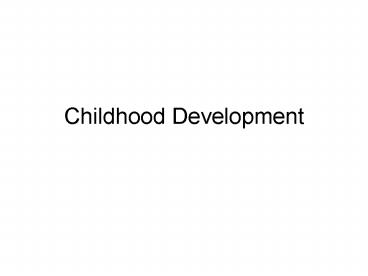Childhood Development PowerPoint PPT Presentation
1 / 23
Title: Childhood Development
1
Childhood Development
2
An Approach to Growth and Development
- Infant development occurs in an orderly and
predictable manner that is determined
intrinsically - Development proceeds from cephalic to caudal,
proximal to distal, and from generalized
reactions to stimuli to specific, goal-directed
reactions that become increasingly precise
3
An Approach to Growth and Development
- Extrinsic forces can modulate the velocity and
quality of developmental progress
4
Areas of Development
- Physical growth
- Motor (gross and fine motor skills)
- Cognitive
- Problem-solving
- Speech and language
- Receptive language
- Expressive language
- Psychosocial
5
An Approach to Development
- Each developmental domain must be assessed during
health supervision visits. - Generalizations cannot be based on the assessment
of skills in one domain - Skills in one domain affect the acquisition and
assessment of skills in other domains
6
An Approach to Development
- Speech delays are the most common developmental
concern seen by the general pediatrician - It is important to distinguish an isolated speech
or articulation delay from a true language delay(
which involves problems with both receptive and
expressive language)
7
An Approach to Development
- It is essential to understand normal development
and acceptable variations in normal developmental
patterns to be able to recognize patterns that
are pathologic and may represent a true
developmental delay
8
Physical Growth
- Growth milestones are the most predictable
although each child must be viewed in the context
of their genetic and ethnic influences - In general, weight loss occurs within the first
six days of life - Regain birth weight by 2 weeks
- Expected weight gain in first six months 5-7
oz./week or 20-30 gm/day
9
Physical Growth
- Birth-weight doubles by 5 months of age, triples
by 1 year - Weight is the first growth parameter to be
affected by malnutrition, head circumference the
last - Height doubles between 3 and 4 years
- By age 2, children have reached about 50 of
adult height
10
Physical Growth
- At birth, the head is 75 of adult size, close to
90 by age 2 years - Head growth in the first 5-6 months is due to
continued neuronal cell division - Later, increasing head size is due to neuronal
cell growth and supporting tissue proliferation
11
Motor Development
- Gross motor development proceeds from a sequence
or prone milestones to sitting then
standing/ambulating - Gross motor milestones do not take quality of
movements into account - Quality of movements are best evaluated in the
motor component of the neurologic exam-
especially, station and gait
12
Motor Development
- The best clues about motor development can be
obtained from observation - Fine motor skills progress as control over
movements of the upper extremities develop - Initially upper extremities are used to balance
- Once balance is achieved, hands become available
for manipulation of objects
13
Motor Development
- As development moves from proximal to distal,
reaching and manipulative skills are enhanced and
manual exploration replaces oral exploration
14
Cognitive Development
- Intellectual development depends on learning that
contains three componentsattention, information
processing and memory - Intellectual development is reflected in
advancing abilities to comprehend, reason and
make judgments - In infants, evaluate intelligence by language and
problem-solving
15
Language Development
- Language development during infancy can be
divided into three periods - Prespeech period (0-10 months)
- Naming period ( 10-18 months)
- Word Combination period (18-24 months)
- Expressive language will lag behind receptive
language
16
Traits that measure Temperament
- Activity level
- The level of physical activity, motion and
restless or fidgety activity in daily activities - Adaptability to change
- How a child adjusts to change or new situations
- Positive or negative mood
- Degree of pleasantness or unfriendliness
- The glass is half empty or half full
17
Traits that measure Temperament
- Intensity of emotional responses
- The energy level with which a child responds
- Rhythmicity of biologic functions
- Presence or absence of a regular pattern for
basic physical functions - Persistence in the face of environmental
counterforces (attention span) - The ability to concentrate or stay on a task
18
Traits that measure Temperament
- Distractibility or ease of soothing
- The ease with which a child can be distracted
from a task or situation - Reactions in new situations or to new stimuli
- Rapid vs. slow, hesitant vs. excited
- Sensory threshold
- Amount of stimulation necessary to produce a
response from a particular child
19
Toddlers Infants Gone Wild
- Physical growth occurs more slowly but still at a
predictable rate- - Weight gain 2 kg/year, height 5-7 cm/yr
- A toddlers behavior style or temperament is
highly visible and influences all interactions - Toddlers transition from sensorimotor to
preoperational thinking
20
Toddlers Infants Gone WildAffective development
- Temperament
- Attachment
- Autonomy/Independence
- Impulse control
21
Toddlers Cognitive Development
- Sensorimotor
- Learns by touching, looking and seeing
- Out of sight, out of mind
- Preoperational
- Child can form mental images and solve problems
by mental trial and error - One object can represent another
- Imitate past events
- Object permanence
22
Preschoolers Toddlers re-tamed
- Still preoperational
- Egocentric or interprets the world in reference
to wants, needs or influences - Associate inanimate objects with human feelings
- Magical thinking-humans cause or create all
natural events
23
School Aged Children
- Acceleration of separation/individuation
- Begin to move to concrete operational thinking
which is manipulation of concrete objects
involving more than one variable - Children are able to classify, number and order
objects - Important tasks in this stage achievement in
school and acceptance by peers

